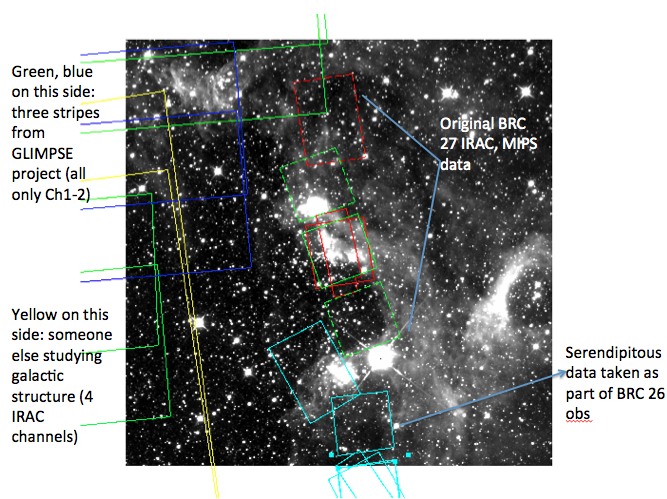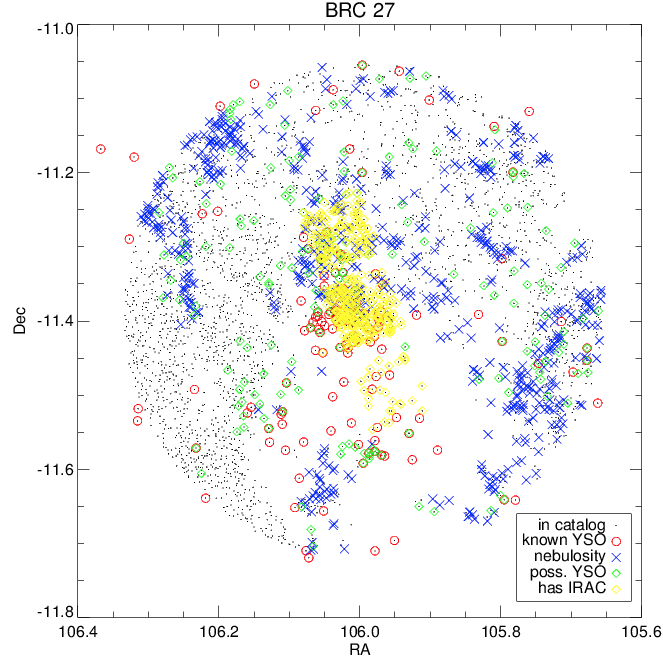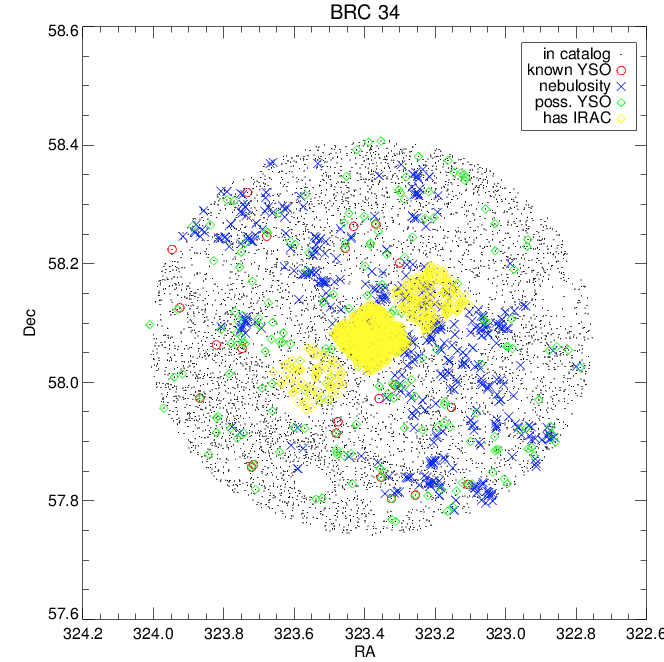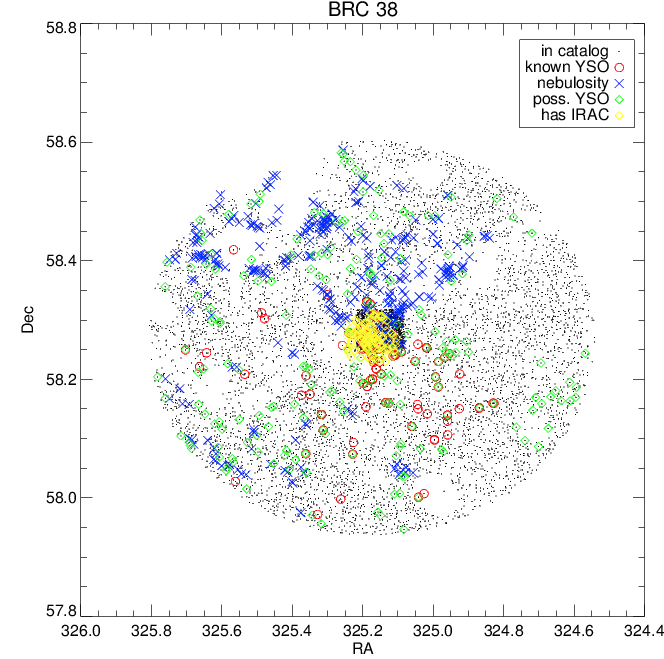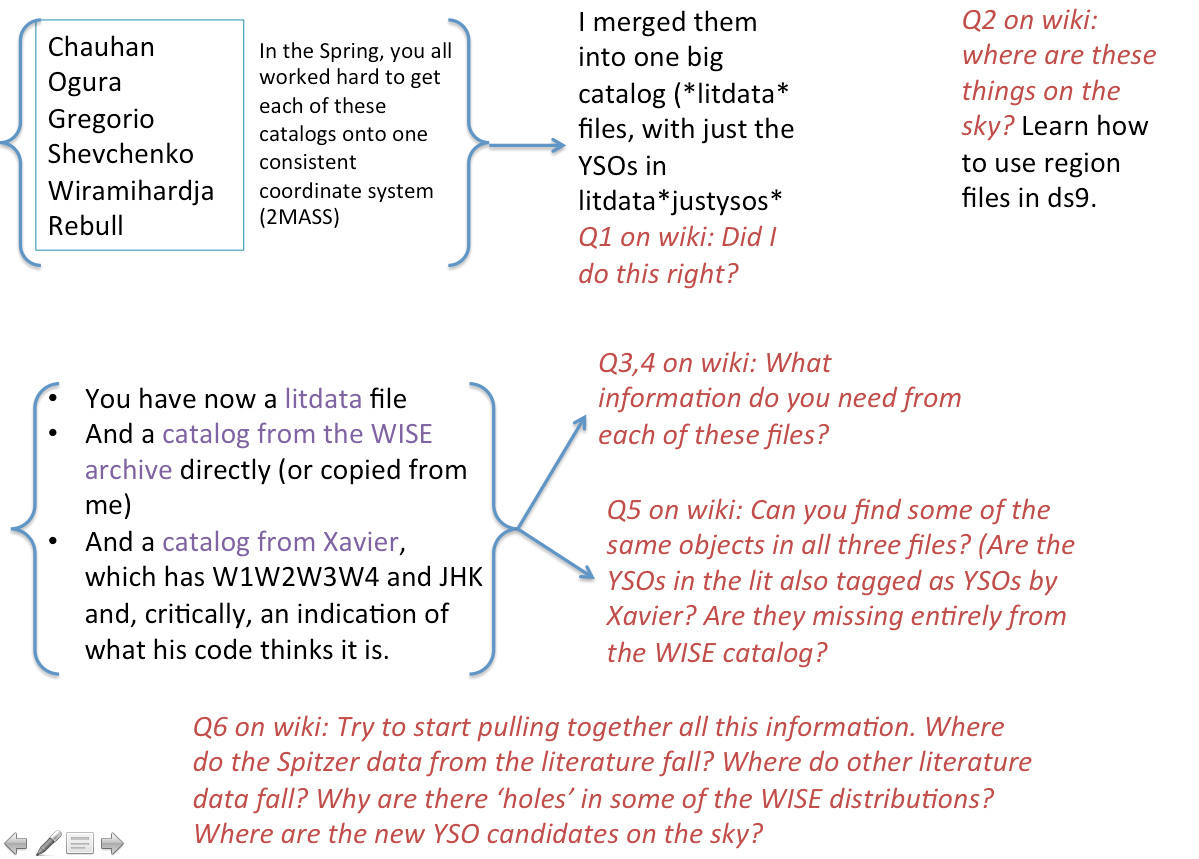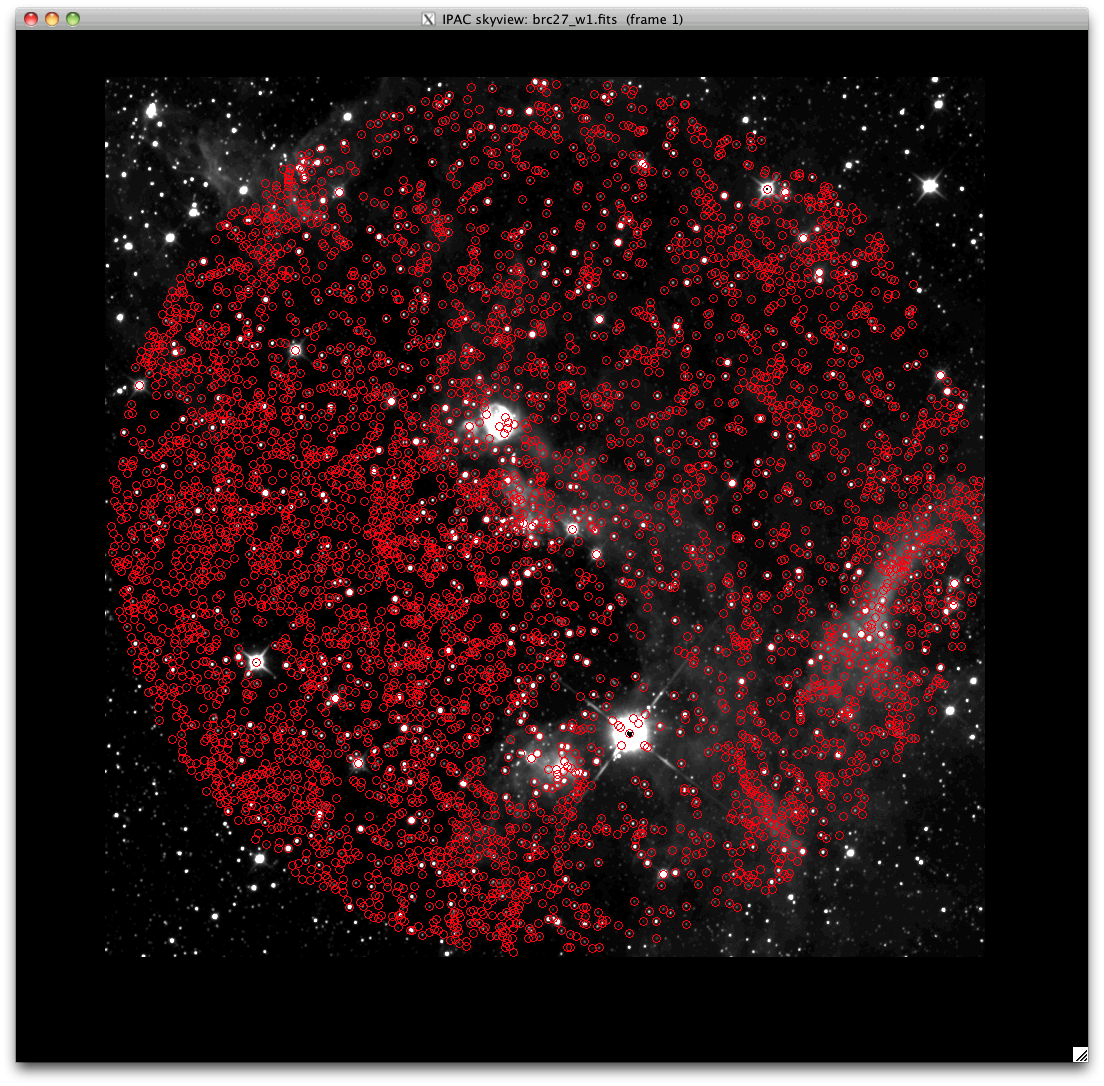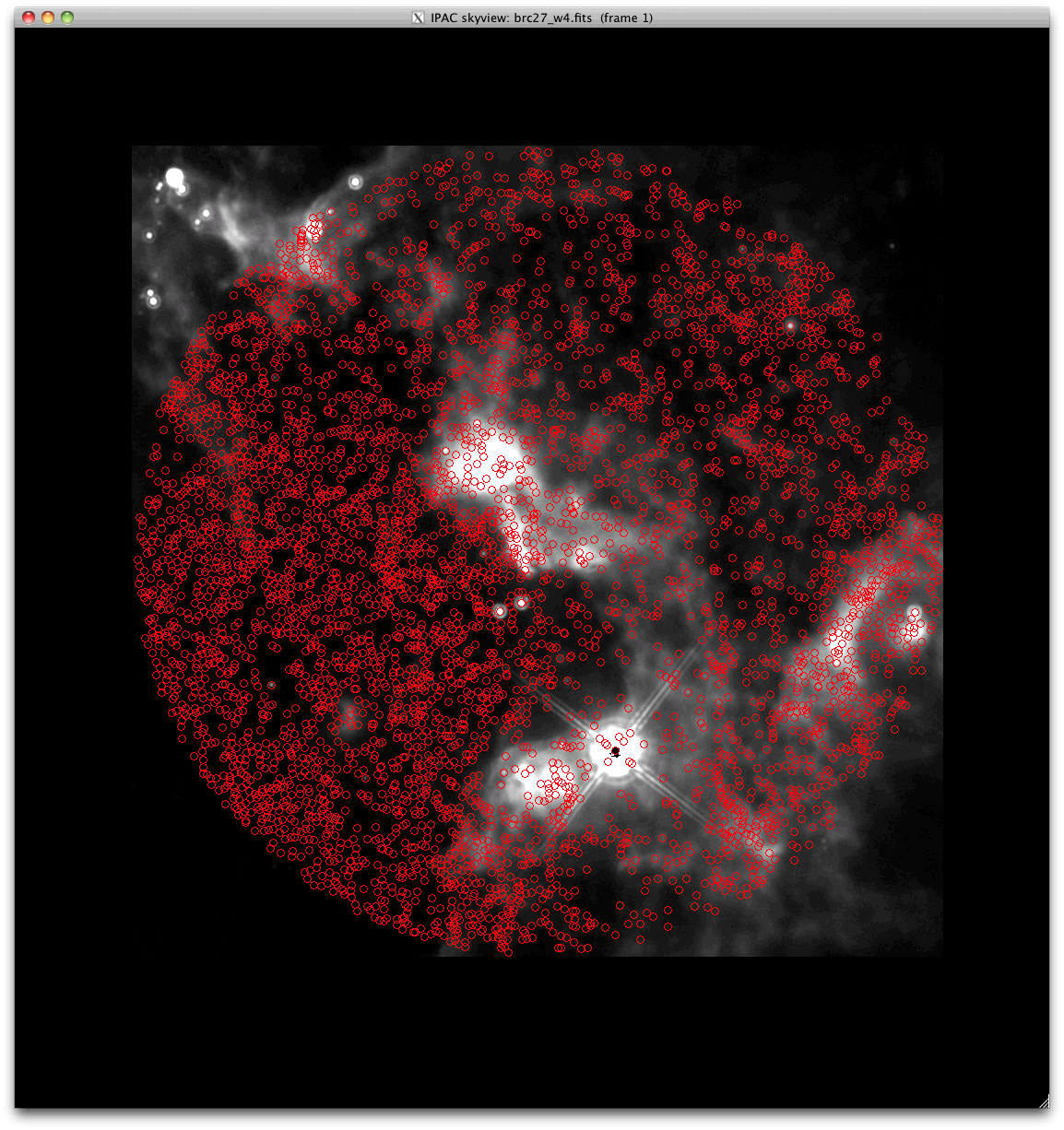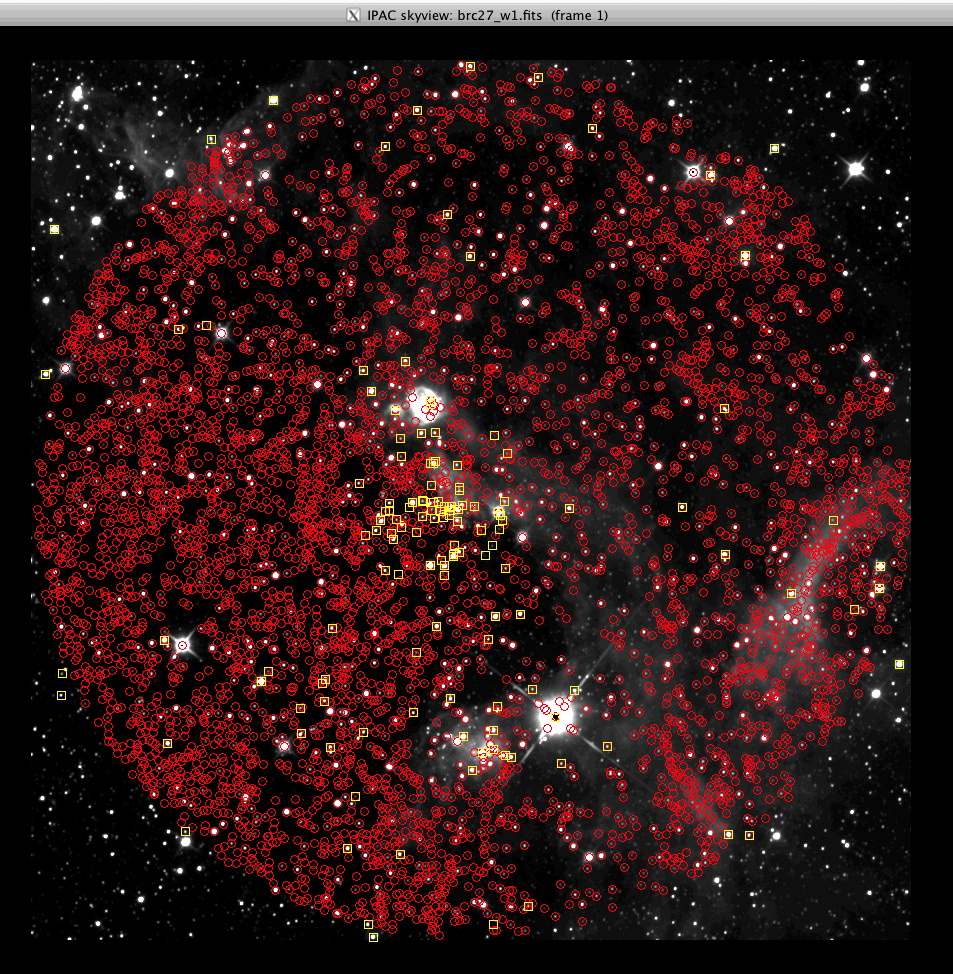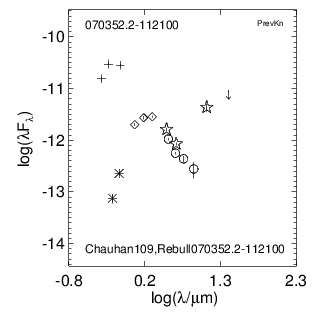Working with the C-WAYS data
This page is an updated version of the Working with the BRCs page, which was an update of the Working with CG4+SA101 page, which was an update of the Working with L1688 page. This page was developed and updated specifically for the 2012 CWAYS team visit. Please note: NONE of these pages are meant to be used without applying your brain! They are NOT cookbooks!
This is presented as a linear progression, but chances are excellent that you will go back and redo different pieces of this at different stages of your work.
FOR REFERENCE: C-WAYS Bigger Picture and Goals
FOR REFERENCE: C-WAYS DVD Contents. Includes instructions on how to force your computer to read any files with an extension you don't recognize (.tbl, .reg).
Contents
- 1 Useful Positions
- 2 Obtaining the data
- 3 Getting data from other wavelengths
- 4 Making and investigating the mosaics
- 5 Previously identified sources
- 6 Starting to work with the data tables
- 7 Bandmerging the photometry
- 8 Interjection from Luisa (originally from Wednesday afternoon ppt, Jul 2012)
- 9 Making color-color and color-magnitude plots
- 10 Investigating the images of the objects
- 11 Making SEDs
- 12 Doing Spitzer photometry
- 13 Putting this in context a little
- 14 Analyzing SEDs
- 15 Writing it up!
Useful Positions
(just for reference)
- BRC 27 07:03:59 -11:23:09
- BRC 34 21:33:32 +58:04:33
- BRC 38 21:40:42 +58:16:12.8
And, we care about stuff within a ~20 arcmin radius of these positions. (which means 40 arcmin on a side if you are pulling a square rather than a cone.)
Obtaining the data
(DONE for brc27, indefinitely pending for other two)
We have 3 regions we care about, so three places to search on the sky. We need to get the relevant data from both WISE and Spitzer.
WISE -- How do I download data from WISE? has a simple walkthrough, with links to more tutorials. And, Access the WISE archive directly here. You will need to get images and catalogs, both, for a 20 arcmin radius from the center position of the three BRCs we are studying.
Spitzer -- How do I download data from Spitzer? has a wide variety of flavors of tutorials. The second formal chapter of the professional astronomer's Data Reduction Cookbook ultimately comes from a 2010 NITARP project. I haven't developed one customized to your project. However, as you know, there will be Spitzer data centered on the BRC we are focusing on, and then other data from other programs within 20 arcmin (radius) of that position. You will need to decide which data actually overlap our region, and download it.
Big picture goal: Get the data you need for this project. Get you comfortable enough to search for your own favorite target in WISE and Spitzer, understand what to do with the search results, and download data.
More specific shorter term goals: Search on our targets. Understand the difference between the observations that are returned. Pick specific observations out of the archive and understand why we picked them. Obtain the relevant catalogs.
Relevant links:
- How do I download data from WISE?
- Access the WISE archive directly.
- How do I download data from Spitzer?
- Access the SHA directly.
Questions for you:
- In WISE, in addition to position, the most important search parameter is the size of the image. What do you need to do to get the data we need?
- In Spitzer, because it was not an all-sky survey, you will pull up several different observations in our regions of interest. Compare the various observations you get as search results. What do you need to search on to get the data we need? How are they the same/different? Which observations do we want to download? You'll need just the Level 2 (post-BCD) mosaics.
- How do you download source lists from WISE, as opposed to images? The catalog will come with 2MASS matches already done, but you can also get catalogs from 2MASS this way; you will need this below.
Updates added July 2012:
- All of the level 2 (pbcd) data within BRC 27 is actually more than 1.5 GB of data, largely because of several very large mosaics that just brush the eastern edge of the region we care about. During the visit, we decided for those purposes to just download the BRC 27 small pointings (AORKEY 17512192 for IRAC and AORKEY 17512448 for MIPS).
- Cheatsheet for filenames of the Spitzer files you get in an SHA download, e.g., which of these files do I want to use? The punchline: *maic.fits are the MosAIC, *munc.fits are the UNCertainties, *mcov.fits are the COVerage. It will sort these into directories by channel and level (e.g., /r17512192/ch1/pbcd/)
- You also have copies of these mosaics on the DVD. The copy on the DVD comes from my own reprocessing last year for last year's NITARP team, so the filenames are a little different (as are the mosaics!).
- Ultimately, you should also download the level 2 (pbcd) mosaics for the other observations that hit the region we care about. On the left is a map of the region with the different footprints indicated; click to get a full-resolution version. Here is a regions file so that you can overlay these footprints on any image in ds9: File:Brc27footprints.reg.txt
Getting data from other wavelengths
(DONE for brc27, indefinitely pending for other two)
You have already done most of this in your literature search and resolution worksheet this Spring. However, if you don't still have the images you found before on your laptop, you might as well go grab them again.
Big picture goal: Understand how to use the various archives to find non-Spitzer data.
More specific shorter term goals: Go get data for both BRCs from POSS (images) and IRAS (images) and 2MASS (images and catalogs) for comparison to our data.
Relevant links: How can I get data from other wavelengths to compare with infrared data from Spitzer? and Resolution
Questions for you:
- Figure out how to get images from at least POSS and IRAS. Get images covering about 20 arcminutes in radius from the center position so that they are easy to compare, but larger scale images might be useful to give a sense of context too. Watch your pixel scale! Start to look at these images in context of the WISE images. Between POSS and WISE, what is bright, and what is faint? Between IRAS and WISE, what breaks into pieces or dissolves into nebulosity when viewed at higher spatial resolution?
- Figure out how to get catalogs from 2MASS. You can do this via the WISE archive. The WISE catalogs come with some 2MASS matches, but the details of the matching process are sometimes a little obscure, so original 2MASS catalogs are also useful. Get catalogs covering about 20 arcminutes in radius from the center position. This will be a big file.
Updates added July 2012: My original suggestion was:
- all 4 WISE bands (from prior step)
- Spitzer IRAC and MIPS (from prior step)
- an optical image (any POSS will do)
- at least one IRAS band (just to compare the spatial resolution)
- and the CATALOGS from 2mass, not images.
Some of you obtained images from 2mass too. That's fine, but hardly required! :)
Making and investigating the mosaics
(DONE for brc27, and, aside from inter-BRC comparisons, done in concept for the others too.)
It is "real astronomy" to spend a lot of time staring at the mosaics and understanding what you are looking at. Don't dismiss this step as not "real astronomy" just because you are not making quantitative measurements. This is time well-spent, and you should plan on investing some time doing this section.
For the WISE data, we can use the mosaics as provided by the WISE archive. Two of our three objects happen to fall on boundaries between tiles as provided, and one of those (BRC 27) is actually on a corner! For when we want to make a big mosaic (or a "pretty picture"), we can either use Goddard's Skyview to make mosaics, or MONTAGE.
For Spitzer data, in the generic case for most targets, you can probably use the online mosaics that come as PBCD (Level 2) mosaics (or delivered products, if they exist for the region you want -- see "enhanced product search" in the SHA). In this case, we can most likely get by just fine with the online mosaics.
Big picture goal: Recognize at a glance what is an instrumental artifact and what is real. Understand what is seen at each WISE and Spitzer band and all the other archival bands.
More specific shorter term goals: Understand what is part of the sky and what is an artifact (e.g., not part of the sky). Understand what might need reprocessing. Recognize how the images differ among the BRCs, and among the various bands.
Relevant links:
- What is a mosaic and why should I care?
- Possibly Making Mosaics Using MONTAGE.
- Goddard's Skyview
- Resolution and associated C-WAYS Resolution Worksheet.
- Why does it matter to know what is an artifact and what is not? So you don't get fooled by stuff like this.
- How can I make a color composite image using Spitzer and/or other data?
Questions for you:
- What is saturated? Are the same objects saturated in all bands? What are some other instrumental effects you can see?
- Notice the pixel scale. What is the real pixel scale of the original instrument (WISE, IRAC, MIPS)? What are the pixel scales of the images? Does that actually change the resolution? (for advanced folks - why did we do this?)
- Compare the mosaics across the bands. What changes? What stays the same? Why? (This is a DEEP question! See also next questions.)
- How does the number of stars differ across the bands? Which band has the most stars? The fewest? (Bonus question: why?) The most nebulosity? The least? (Bonus question: why?) Are there more stars in the regions of nebulosity, or less? Why?
- SKIPPED THIS : If you chose to download data from more than one of our BRCs, do the star counts differ among the three BRCs? Why? (skipped because skipping other BRCs for now)
- SKIPPED THIS : How big are any of the features in the image (nebulosity, galaxy, space between objects)? (What do I mean by big?) in pixels, arcseconds, parsecs, and/or light years? (Hint: you need to know how far away the thing is. If it helps, there are 3.26 light years in a parsec.)
- Make a three-color image. What happens when you include a MIPS-24 or WISE-22 mosaic in as one of the three colors with shorter bands as the other two colors? (NB: this might be easiest within the same telescope, e.g., use just WISE bands or just Spitzer bands to make a 3-color image.) Do the stars match up? Does the resolution matter? Can you tell from just a glance at the three-color mosaic which stars are bright at 22 or 24 microns?
- How much more detail do you see with Spitzer that was missed by WISE? or IRAS? How does the resolution and sensitivity vary?
Updates added July 2012:
- I suggested that you might want to keep a list of the bands, their wavelengths, and the pixel scales (as per question above). Here is the assembled list I had. There is no guarantee I have it all right; I assembled this more or less at the same time you were doing so!
| band | wavelength | pixel scale and notes |
| WISE 1 | 3.4 um | pixels are 1.4 arcsec; resolution is ~6 arcsec |
| WISE 2 | 4.6 um | pixels are 1.4 arcsec; resolution is ~6 arcsec |
| WISE 3 | 12 um | pixels are 1.4 arcsec |
| WISE 4 | 22 um | pixels are 1.4 arcsec; resolution is ~12 arcsec |
| POSS (aka DSS) | optical (~0.55 um) | ~1 arcsec |
| 2MASS J | 1.25 um | ~1.5 arcsec |
| 2MASS H | 1.65 um | ~1.5 arcsec |
| 2MASS K | 2.17 um | ~1.5 arcsec |
| IRAC 1 | 3.6 um | 1.2 arcsec native, 0.6 arcsec mosaic |
| IRAC 2 | 4.5 um | 1.2 arcsec native, 0.6 arcsec mosaic |
| IRAC 3 | 5.8 um | 1.2 arcsec native, 0.6 arcsec mosaic |
| IRAC 4 | 8 um | 1.2 arcsec native, 0.6 arcsec mosaic |
| MIPS 1 | 24 um | 2.55 arcsec native, 2.45 arcsec mosaic |
| MIPS 2 | 24 um | 9.98 arcsec native, 4 arcsec mosaic |
| IRAS 1 | 12 um | 0.75 ARCMIN NOT ARCSEC |
| IRAS 2 | 25 um | 0.75 ARCMIN NOT ARCSEC |
| IRAS 3 | 60 um | 1.5 ARCMIN NOT ARCSEC |
| IRAS 4 | 100 um | 3 ARCMIN NOT ARCSEC |
- We skipped the comparison to other BRCs because we are only doing one for now.
- We skipped the "how big" question as extraneous to the task at hand. Feel free to investigate later if you are interested.
- We were able to make 3-color mosaics using ds9. I think we talked about the difference in resolution at 22 and 24 microns, compared to other data from those same telescopes, but I am not sure we emphasized the answers to the last question above.
Previously identified sources
(DONE, essentially, except for the final search of SIMBAD of our final candidates)
You've already done the bulk of this prior to the visit, but you should look at images, and spot-check my matching! This is probably done more easily as part of the next step.
Big picture goal: Understand what has already been studied and what hasn't in the 3 regions we care about.
Relevant links:
- How can I find out what scientists already know about a particular astronomy topic or object?
- I'm ready to go on to the "Advanced" Literature Searching section
- C-WAYS source matching work -- NOTE THAT i added updates in green for each paper.
- C-WAYS Spring work (see "papers to discuss")
- YouTube video on how to take antiquated coordinates from one of our literature papers and use 2MASS to get updated current, correct coordinates for each object.
IMPORTANT: when we are done weeding source lists as per the below, we will have to get into SIMBAD and search for each of our sources, just to get another handle on whether or not anyone has done anything on them before -- because some of our sources are beyond where the prior papers were working, and they just might be something else in the literature.
Updates added July 2012:
- Several of the teachers did in fact do the spot checking, and as no one found anything weird, we are probably ok.
- Several of you noted 'interesting' objects, and we did not do a good job of systematically collecting these notes.
Starting to work with the data tables
(pretty much DONE for brc27, indefinitely pending for other two)
OK, fair warning, some math involved, and the start of working with spreadsheets!
Big picture goal: Learn how to manipulate data tables.
More specific shorter term goals: Understand how to import plain text tables into Excel (or another spreadsheet of your choice). Really look at the files as retrieved from the WISE archive and look at files as sent by Xavier and determine the relevant information out of these catalogs.
Relevant links:
- YouTube video on what tbl files are, how to access them, and specifically how to import tbl files into xls. (10min)
Questions for you:
- You have already obtained updated coordinates from each paper, for each BRC. I took your lists and matched them; copies of these files are on the DVD and they should import cleanly into xls, but be careful about the limits (see below). Spot check a few. Did I match them correctly? Which ones are the same between papers and which are new to just one paper?
- FILES YOU WANT: File:Tableforvisit1396 justysos.txt and File:Tableforvisit27 justysos.txt
- CAUTION 1: Some of the literature reported whole data tables, and some just reported the YSOs. So there are files with everything in the literature (long) and files with just the things someone in the literature tagged as YSOs. The files you want are the ones that are just the ones someone in the literature tagged as YSOs.
- CAUTION 2: Because several of the source lists I had for BRC34 and 38 were of the entire IC1396 complex, I just combined the whole thing into one file tagged "1396".
- CAUTION 3: I did NOT do a good job documenting these files. Shame on me. Should have a date (missing), and should explain the columns. "rebullwhyhere" is the note from last year's BRC paper as to why we were caring about it -- was it a previously known source, did it have an IR excess? The column "yso" is =1 if it is tagged as a yso; everything in the "justysos" files do, but not everything in the full files have yso=1. See also next item...
- CAUTION 4, AND THIS ONE'S A BIGGIE: This file has a mixture of detections and limits, measurements and errors, flux densities and magnitudes (with two different definitions of the latter!). The UBVRI are all Vega mags, no limits, and only some have errors. The Sloan r and i bands do have some limits, and these are AB mags. The JHK are all Vega mags, and some have limits. The IRAC and MIPS data are all in FLUX DENSITIES (uJy), and often have limits. Just to add to the confusion (sorry!!!) the limits for this entire file are ALL IN FLUX SPACE, e.g., the sloan r mag for 07040072-1123234 is a limit, listed as 20.60, with a < (less than) sign; what this really means is "the true value of this object in this band is somewhere fainter than this value." For mags, this should be a GREATER number. So I just screwed up, but since I already burned all the DVDs, it's probably easier to explain it than fix it at this point.
- For each of the known objects, you have the RA/Dec - what is the easiest way to find the objects in the images you obtained above? (Hint: you want a ds9 regions file: File:Brc27knownysos.reg.txt File:Ic1396knownysos.reg.txt) Take notes on any that look like the photometry may be corrupted or that you can easily dismiss as galaxies or other contaminants now that you are looking at better and/or different data than they had before.
- Look at the files from WISE and from Xavier. The files from WISE are better documented in the top of the file than mine are; Xavier's files have documentation in a separate file. How is the information presented in the WISE catalogs and Xavier's catalogs the same/different? What information do we need?
- How do you figure out which ones have bad photometry according to the data quality flags?
- For each of the known YSOs, you have the RA/Dec - find the same objects in the WISE catalog. Which objects are the matches? What constitutes a 'match'? Are there any with no matches?
Now, start to pull together stuff from this step plus those above. Here are plots (click to get a big one) of the spatial distribution of sources in all three regions we care about, with the symbols as defined in the plots (black dot = object in catalog, meaning WISE+literature data+my Spitzer catalog from last year's group; red circle = identified in the literature as a YSO; blue x = identified by Xavier's automatic code as likely clump of nebulosity; green diamond = identified by Xavier's automatic code as possible YSO; yellow diamond = IRAC data available in the catalog). Why are there some regions where WISE sources are missing? Why are the Spitzer sources where they are? (Is this all the Spitzer sources that are possible, or not? Why?) Why is there a patch of black in BRC 38 (hint: Beltran et al.)?
Updates added July 2012:
- OK. Here was the leading edge of the confusion on source lists. The version from the DVD and the version that I posted on my personal website are a little different, with the latter (more recent) one being better to use. Most of the caveats above still apply.
- On the right is an attempted copy of the stuff I was writing which seemed to help better explain the relationship between these source lists and the questions.
Updates added 19 July 2012: One of my (Luisa's) action items was to look into the 'holes' in the spatial distribution of sources in BRC 27. I overlaid the full wise catalog on the WISE mosaics from Xavier. Of the three images here, there are two that have the whole catalog overplotted -- one is w1 and the other is w4; look at the header of the window in the screen snapshot to see which is which. The third has yellow squares too; see below for that.
things to note:
we did a cone search on the wise catalog, and xavier made a square mosaic. so we 'lose' the corners. which is fine; we have a ton of other things to worry about with the objects we have.
there are far more sources seen at w1 that w4 (and you should know why by now!) :) most of the red circles are nicely on sources seen in w1; there are far fewer sources in the w4 image.
if you draw a virtual line across the circle of sources from "11:00" to "4:00", the surface density of sources (e.g., how many sources there are on the screen per chunk of screen) is much higher on the lower left than on the upper right. if you look at the w1 image, you can see that this is for the most part consistent with what you actually see. at "12:00", i really don't see any sources (or many sources) in the black in between sources. it's even doing a pretty good job finding sources on top of the nebulous regions in the image, though some of them are likely to be false sources created by the computer doing the source detection 'seeing' ridges of nebulosity as instead sources.
but the bottom middle is more of a problem. there is a bright source and nebulosity there. and i can see taht it caught a lot of the sources there. but there are a lot of legitimate sources, some reasonably bright, in those holes of "no catalog sources".
THIS MEANS that if there are new legitimate YSOs here, we will not find them because they are not in the catalog. fortunately, not many of them are very bright, otherwise i would be worried. fainter means more likely to be xgal.
THIS ALSO MEANS that if any of our known objects fall in this region, they will appear to not have WISE detections when instead they actually should.
So, i plotted up everything on W1 - red circles is still the wise catalog, and now yellow boxes are the catalog of known YSOs.
there are several yellow boxes that are just outside of our 20 arcmin radius region of interest; i think it's ok to drop those off our list of things to think about.
Most of the yellow boxes also have a red circle underneath. but there are many, especially in the region with no wise sources in the catalog, where i can see something in the image, it's just not in the catalog. there are several of these. i count 8 or 10 at least. most of these already have IRAC photometry, so we probably have enough to work with them. only a few are going to be problem children. for the purposes of the poster we can just 'punt' and say "these can be seen in the wise image but we don't yet have wise photometry for them." in the long term, we will either have to persuade the wise team to do the photoemtry for them, or we will do aperture photoemtry on the UNCALIBRATED wise image for these targets and ~10-20 others of comparable brightness that ARE in the wise catalog and then bootstrap the calibration and interpolate what the wise photometry of these objects really are.
we will have to make note of any others that are in the 'known yso' list, within 20 arcmin of the center (eg not in the corners), and missing wise photometry, then go look into them.
Bandmerging the photometry
(really just for reference)
This step was an explicit step in the journal articles we read, so I'm leaving it in here as a conceptual step. For our project, the WISE data is already matched to 2MASS, so we don't need to do that. I already merged all the literature photometry together into one file, so we don't need to do that. We need to merge the WISE catalog to the literature catalog, as well as the Spitzer and optical photometry we're going to do below. You have already done at least some of the WISE-to-literature merging above. Conceptually, we need to bandmerge before we can make color-color plots, which is why this step is here.
Big picture goal: Understand what this process is, since there were questions about it when we were reading the literature.
More specific shorter term goals: You identified some of the literature objects above in the WISE catalog. For at least some of them, identify which of these objects are in the WISE catalog, and add the photometry (and errors) for those bands to the row for each object. You will have a LOT of Excel columns, especially when you get into the flux conversions for SEDs below. You may wish to start pulling off just the YSOcandidates+literature sources (out of the entire catalog) into at least a separate workbook tab.
Relevant links: Resolution
For completeness: The WISE catalog provides some matches to 2MASS, but it is unclear to me exactly where those matches come from, like which sources out of the 2MASS catalog did they use (which error flags did they keep, or did they just look for any matches in the 2MASS catalog?). When I take the WISE catalog's 2MASS matches and compare it to the 2MASS catalog I pull out of Gator myself, I find about 3% fewer matches than the WISE catalog does. I use a matching tolerance of 1 arcsec to match up sources. These 'extra' 3% must be either objects matched to the WISE source that are more than 1 arcsec away, or with a different set of error flags than I would use coming out of 2MASS. What this means in practice is that: (a) we can keep and use the WISE catalog's matches to the 2MASS sources; (b) we should remember this caveat, and if we notice any 2MASS data downstream from here that is weird (like a mismatch in the SED), then we should go back and check those 2MASS matches by hand with the original 2MASS catalog.
Interjection from Luisa (originally from Wednesday afternoon ppt, Jul 2012)
- We have a bunch of literature-identified YSOs. (*litdata*yso* files above)
- We have a bunch of CANDIDATE YSOs identified by Xavier out of the WISE+2MASS catalog.
- NOT ALL OF THESE LITERATURE YSOs WILL BE REDISCOVERED BY XAVIER. There will be some undetected, or some without IR excesses. That is why I assembled the "table of interesting objects" (File:Tableforvisit27 interesting.txt), which consists of anything that anyone else tagged as a YSO PLUS anything that Xavier tagged as possibly a YSO.
- NOT ALL OF THESE CANDIDATES WILL BE REAL YSOs. There will be MANY contaminants.
- One way we weed out the contaminants is to assemble color-mag and color-color plots and look at where the objects fall in those diagrams. (A start on this is the next step; we will come back to it.)
- Another way we weed these out is to assemble SEDs (with as much data as we can) and look at them. (Another step below, which will also be visited more than once.)
- Another way we weed these out is to look at the images everywhere we can. (Another step below, which will also be visited more than once.)
Making color-color and color-magnitude plots
(toe-dipped for brc27, indefinitely pending for other two)
OK, fair warning, some math involved, and the start of programming spreadsheets!
Big picture goal: Understand what plots to make. Understand the basic idea of using them to pick out certain objects.
More specific shorter term goals: Make some color-color and color-mag plots using the data imported into Excel in the last step. Understand at least the first few steps of the Koenig et al method in detail. If you can, program the spreadsheet to make the color cut and keep track of which objects pass or fail. At the very least, make a plot of the entire distribution and highlight the YSO candidates from Xavier.
Relevant links:
- Color-Magnitude and Color-Color plots
- Gutermuth color selection - mostly currently Gutermuth color selection; includes analogy with M&Ms. Koenig color selection is similar in concept but uses different bands.
- Finding cluster members
- Color-color plot ideas
Questions for you:
- Pick at least one color-color or color-magnitude plot to make. Figure out a way to ignore the "no data" flags (exactly what they are depends on which file you are starting from). Does the photometry seem ok? Where are the plain stars? Where are the IR excess objects? START FROM A COMPLETE WISE CATALOG FOR STARTERS.
- Which objects are selected by Xavier's method as YSO candidates? You may wish to overplot them with a different color/shape symbol. You may wish to try drawing the line segments on the plot too. OVERPLOT XAVIER'S YSOS ON THE SAME PLOT. Note not Xavier's entire catalog, but just the YSO candidates.
- Are the literature sources tagged as YSO candidates by Xavier or not? You may wish to add them with another color/shape symbol. I DO NOT BELIEVE WE GOT TO THIS.
- Optional next step (may help with larger concepts, or doing this yourself from scratch) - Taurus catalog has a catalog of legitimate young stars. Where do these objects fall with respect to either the Gutermuth or Koenig colors? Which ones would be retrieved or lost by these color selections? Do the YSO candidates that Xavier sent us have colors like (most of) these YSOs? (Hint: Make a color-color or color-magnitude plot of the entire distribution in the catalog, highlight the YSO candidates with one color symbols, and add the Taurus YSOs to the plots using a different color symbol.)
Updates added July 2012:
- When reading in Xavier's file, it is tab-delimited.
- When reading in the wise.tbl file, get rid of the first 110 lines, and then parse both on spaces and "another character" (tick that box) and enter "pipe" (which means something in wikitext, so I can't enter it, but it is commonly the character obtained by hitting shift and the \ key (often above your enter key).
- Most of the group accomplished a W1-W2 vs W3-W4 plot. W1-W2 is centered on zero, because most of the objects seen in W1 and W2 are plain stars, so the color is zero. W3-W4 is notably NOT zero, because the only objects seen at W4 are the ones notably bright at W4, so they all are brighter than plain stars at W4. This gave me a minor heart attack until I figured it out.
- Some of the group accomplished a K vs. W1-W4 plot, or a W1 vs. W1-W4 plot. These look like what I expected. The YSO candidates are bright and red, generally.
- There are other CMDs you can try. See the CG4 paper or the Taurus paper or Xavier's paper (appendix) for ideas.
- After we get some optical data, there will be even more CMDs we can try. We will come back to this.
Investigating the images of the objects
July 2012: pending for all of them - put off because can do training for this over the phone
This will take some time to complete, and we may not be able to finish it for any one cloud while you are in California.
Big picture goal: Understand why we need to look at the images of each of our short list of candidates and get started actually doing it and weeding. Also look at any previously identified objects that were not selected by the color cuts.
More specific shorter term goals: Figure out how to get images and/or find these things in our images. Calibrate your eyeball for the various images/resolutions/telescopes to figure out what is extended/corrupted/galaxy-like and what isn't. Drop the bad objects off our candidate YSO list.
You will need to obtain images of the objects in at least WISE, POSS, and 2MASS. You can do this using the WISE archive and IRSA finder chart, or the big images from before coupled with ds9 regions files. Either way, it takes time. I recommend doing all the WISE first using the WISE archive interface (you can submit a batch list of targets), then all the 2MASS+POSS separately as a second pass using Finder Chart or the WISE archive interface. (You will ultimately need to examine the images from Spitzer and our optical data too, but let's hold off on this for just now.) For each of these image sets, it will take a while to calibrate your eyeball, so you will probably need to do the whole list, and then go back and redo the first several or so to be sure that you have it right. REAL examples of non-point source things: (a) search in Spitzer on HIP 32435 for MIPS 24 um data. Several of the mosaics there contain only point sources. One, though, centered on this target, does not look like all the others. I think this is a star superimposed on a background galaxy. What do you think? (b) search in WISE on "LEDA1684111". This object passes Xavier's photometry cuts for having colors like a YSO. Does it look like the other point sources in the image? I think it looks like a galaxy, or possibly source confusion (e.g., two point sources very close to each other)
Relevant links:
- How can I get data from other wavelengths to compare with infrared data from Spitzer?
- Resolution (specifically some of the concrete examples there)
- WISE archive
- IRSA finder chart
- YouTube video on using Finder Chart. To use these small images to also examine larger images, load them (and the larger images) into ds9, pick one of the small finder chart images, and then pick 'Frame/Match/Frame/WCS'. All will snap to alignment with North up, on the same scale, with the object in the center.
Files that may be useful: File:Tableforvisit27 interesting.txt File:Tableforvisit34 interesting.txt File:Tableforvisit38 interesting.txt - generated using more or less the same code as my catalogs of previously known YSOs above, with all their caveats. These files contain anything that is previously known OR provisionally identified as a YSO by Xavier's code.
Questions for you:
- Which objects are still point sources at all available bands?
- Which are instrumental artifacts? Or instrumental hiccups?
- Which might have corrupted photometry?
Making SEDs
(toe-dipped-in for brc27, indefinitely pending for other two)
WARNING: lots of math and programming spreadsheets here too... you WILL do this more than once to get the units right!
Big picture goal: Understand how to convert magnitudes back and forth to flux densities. Understand what an SED is and why it matters.
More specific shorter term goals: Program a spreadsheet to convert between mags and flux densities. Make at least one SED yourself. Examine the SEDs for all of our candidate objects. Use them to further evaluate the quality of the YSO candidates from the YSO candidate list.
Make sure you understand how to get the fluxes from the magnitudes. This is not easy to do right the first time, so you will get the wrong answer the first few times you try. CAUTION: Sloan bands (including the optical data from Rebull et al. 2012 or new data from FTN) are in AB mags, not Vega mags! IPHAS data are in Vega mags.
You may wish to use the files I gave you in the previous step.
Relevant links:
- Units
- SED plots
- Central wavelengths and zero points
- Studying Young Stars
- the detailed object-by-object discussion in the appendix of the cg4 paper.
- maybe this would be useful - i just learned about this, and haven't investigated it at all.
Pick some objects to plot up, maybe some of the previously-identified ones from above would be a good place to start, or the ones you flagged above as having an IR excess. Start with just one. You will ultimately plot log (lambda*F(lambda)) vs log (lambda) -- see the Units page. It will take time to get the units right, but once you do it right the first time, all the rest come along for free (if you're working in a spreadsheet). Spend some time looking at the SEDs. Look at their similarities and differences. Identify the bad ones, and discuss with the others why/whether to drop them off the list of YSO candidates. See also stuff above about data at other wavelengths, and include literature/archival data from other sources where appropriate and possible. Make sure to keep careful track of those things that are limits rather than detections.
Questions for you:
- What do the IR excesses look like in your plots? Do they look like you expected? Like objects in CG4 or Monday's ppt or elsewhere?
- Make some SEDs of things you know are not young stars for comparison - pick some with zero IR color. What do they look like?
- Which objects look like clear YSO SEDs? Which objects do not?
- What's the deal with this one (why does it look like this)? (In my SED, the y-axis units are cgs units [sorry], *=FTN data, +=optical literature data, diamonds=2mass, circles=irac, stars=WISE, arrows=limits, and boxes=MIPS if they exist, which they don't here.)
Updates added July 2012:
- What do you have? UBVRI, JHK, WISE data in Vega mags. ri data in AB mags. IRAC, MIPS data in microJanskys.
- What do you need to get? everything into Jy, which are units of Fnu. Then convert your Fnu in Jy into Fnu in cgs units, ergs/s/cm2/Hz, so multiply by 10^-23. Then convert your Fnu into Flambda in cgs units, so multiply by c/lambda^2, with c=2.99d10 cm/s and lambda in cm (not microns!). Then get lambda*Flambda by multiplying by lambda in cm. Plot log (lambda*Flambda) vs. log (lambda).
- I believe that most of you were just trying to get JHK+WISE bands onto an SED. Ultimately, you need to get "all the bands we can" on each SED for each "interesting" object. We have UBVRI for several literature objects. We have FTN r,i for lots of objects near the middle (and will get more). We have IRAC, MIPS data for SOME of the sources. We can obtain more for SOME of the remaining ones.
- Once you make your first SED correctly, the rest are easy.
- Then you need to look through each of the SEDs and decide which look like you expect, which need photometry to be checked, and which seem unlikely to be legitimate YSOs. This is a judgement call, and your judgement will improve with time, just as it did for the source matching in the Spring.
- The issue with Chauhan109 above is that there is a bright nebulous patch in the WISE images that either is being inappropriately tagged as a point source (with its flux densities attached to this source) or whose brightness is contaminating the photometry beyond recovery. The Spitzer data is critical for sorting out what is going on here. This will not be the first time we are grateful for Spitzer data. (And I still don't know what is going on with the optical data - it's wrong for this source, but this is the best possible match given the information we have in the literature.
Doing Spitzer photometry
toe-dipped-in for BRC 27; indefinitely pending for the other two BRCs
OK, this step is going to take the longest, be the most complex, and involve the most steps out of everything so far.
Never just trust that the computer has done it right. It probably did what you asked it to do correctly, but maybe you asked it to do the wrong thing. Always make some plots to test and see if the photometry seems correct.
Big picture goal: Understand what photometry is, and what the steps are to accomplish it. Do photometry on a source-by-source basis for the 'interesting' sources. Understand the units of Spitzer images. Understand how to assess if your photometry makes sense.
More specific shorter term goals: Do photometry on all the Spitzer mosaics for the sources that have survived so far as YSO candidates (or YSOs from the literature). Assess whether your photometry seems right. Add it to the SEDs.
Relevant links:
- Units
- Photometry
- I'm ready to go on to a more advanced discussion of photometry
- Aperture photometry using APT, specifically this, which is the closest thing to a cookbook I will give you.
- YouTube video on using APT, including calculating the number APT needs. (15 min because it starts from software installation and goes through doing photometry.)
To start, we should decide as a group which small set of sources to measure, and have everyone measure the same sources. We will then compare all of our measurements among the whole group. Ultimately, we will need to measure photometry for everything we care about that falls in the Spitzer maps.
The measurements you get from the Spitzer images will come in Jy (microJy or milliJy). You will need to convert these into the right units for addition to the SEDs. And, probably, you will need to convert these flux densities back into magnitudes for use in color-color and color-mag diagrams, though we may or may not get to this point in July.
Steps:
- obtain a ds9 regions file for the YSO candidates surviving to this point. (should have from tasks above)
- obtain the big Spitzer mosaics (should have from tasks above)
- For each source in the image, identify x, y in each of the 4 IRAC channels and at least the first MIPS channel (24 microns). You should look at the MIPS-2 (70 microns) images, but few sources are expected in this channel. CAUTION: it is NOT going to be the same x, y in each image, and the sky coverage will NOT be the same for each channel (meaning that if the source is not in I1 it may be in I2, I4, and M1 but not I3. Sources WILL have the same RA and Dec, of course.
- While you are doing this, make note of the properties in the image of each source. Does it look clean or corrupted by a nearby object, an instrumental artifact, etc.?
- Go load the image into APT. Explore the parameters so that you understand what is going on. When you are ready to get to work, Measure photometry for all the sources in this image. Make sure the units work out such that you get the right numbers. Repeat for each channel, each Spitzer pointing.
- Add the photometry for the Spitzer bands to your master catalog for the corresponding source. ('bandmerging' by hand again!)
- Convert the flux densities to magnitudes for later use. (you may put this off until later if time is short)
- Make SEDs for these objects using these additional points.
Questions for you:
- Use APT to explore the various parameters. What is a curve of growth?
- What are the best parameters to use? (RTFM to find what the instrument teams recommend.) What are the implications of those choices? What happens if you use other choices?
- Does the addition of the Spitzer points change your opinion on which YSO candidates are going to survive to the end of this process?
- You can repeat this on the optical data, but Russ has helpfully reduced the data we have so far. Obtain the full catalog, identify the source matches, and add those points to their corresponding SEDs. CAUTION: these are AB mags, not Vega mags. Does the addition of the optical points change your opinion on which YSO candidates are going to survive?
- Look at the new photometry with a critical eye. Which points look like they should be double-checked?
Updates added July 2012:
- We only barely got started on this. I picked 5 sources to try, semi-randomly:
- 07040225-1125429
- 07040994-1118251
- 07040234-1125393 (awfully close to first one)
- 07040123-1122426 (fainter)
- 07040215-1125122 (fainter)
and I picked badly for at least 2 or 3 of the 5. The last two on the list are probably the best ones to try, and we will probably agree better on those (once you get to them) than the first three.
- The image, when loaded into APT, is NOT north-up. There are three ways we came up with to find the object in the image:
- load the image into ds9. put north up. find the object. now find the object in the image in APT.
- load the image into ds9. put north up. find the object. note the x and y. type the x and y into APT.
- under APT's tools, look for an option like "object locator" and type in the coordinates. It should be ##h##m##s and -##d##m##s format. One person could not make this work. Most of the rest seemed to be able to make this work.
- For making CMDs/CCDs, you need magnitudes. For making SEDs, you need flux densities. Sometimes you get magnitudes from archives, and sometimes you get flux densities. You need to be able to convert fluently between these quantities.
- When comparing multiple teams' measurements of the brightness of an object, it is easier to do if converted to magnitudes first.
Putting this in context a little
This step is important for this particular project, because of the nature of the existing literature for the objects we are studying. Again, we may or may not get to this before you leave California.
Big picture goal: Understand how what we did is different than what others (Chauhan, Choudhury, (Rebull/Johnson)) did with the IRAC (IRAC+MIPS) data to find young stars.
More specific shorter term goals: Knowing what you do now, go back and reread Chauhan et al. and Choudhury et al. Do a detailed comparison of our method for finding young stars and that from those two papers.
Relevant links: How can I find out what scientists already know about a particular astronomy topic or object? and I'm ready to go on to the "Advanced" Literature Searching section and C-WAYS Spring work.
Questions for you:
- What are the steps (cookbook-style) that Chauhan et al. used to find YSOs?
- What were our steps?
- How are they different?
- Did we recover all of the young stars identified in the literature? Some will not have IR excesses, so those will not be recovered by an IR-based color selection.
Analyzing SEDs
This is advanced, and we may not get here.
Add a new column in Excel to calculate the slope between 2 and 8 microns in the log (lambda*F(lambda)) vs log (lambda) parameter space. This task only makes sense for those objects with both K band and IRAC-4 detections. (For very advanced folks: fit the slope to all available points between K and IRAC-4 or MIPS-24. How does this change the classifications?)
- if the slope > 0.3 then the class = I
- if the slope < 0.3 and the slope > -0.3 then the class = 'flat'
- if the slope < -0.3 and the slope > -1.6 then class = II
- if the slope < -1.6 then class = III
These classifications come from Wilking et al. (2001, ApJ, 551, 357); yes, they are the real definitions (read more about the classes here)!
- How many class I, flat, II and III objects do we have?
- Where are the objects with infrared excesses located on the images? Are all the Class Is in similar sorts of locations, but different from the Class IIIs?
For very advanced folks: suite of online models from D'Alessio et al. and suite of online models from Robitaille et al.. Compare these to the SEDs we have observed.
Writing it up!
We need to write an AAS abstract and then the poster, and if we're lucky, a paper!
We need to include:
- How the data were taken.
- How the data were reduced.
- What the Spitzer properties are of the famous objects, including how the Spitzer observations confirm/refute/resolve/fit in context with other observations from the literature.
- What the Spitzer properties are of other sources here, including objects you think are new YSOs (or objects you think are not), and why you think that.
- How this region compares to other regions observed with Spitzer.
Take inspiration for other things to include from other Spitzer papers on star-forming regions in the literature.
